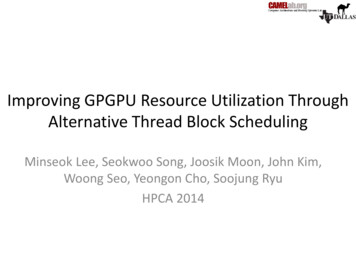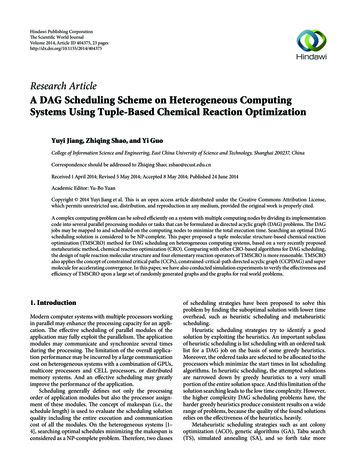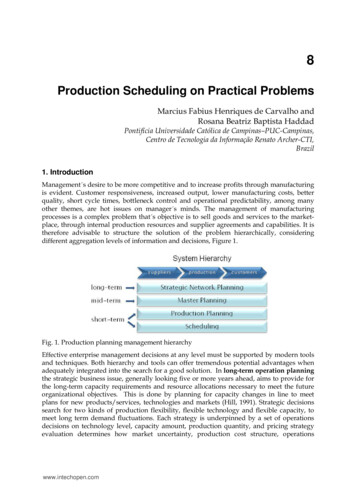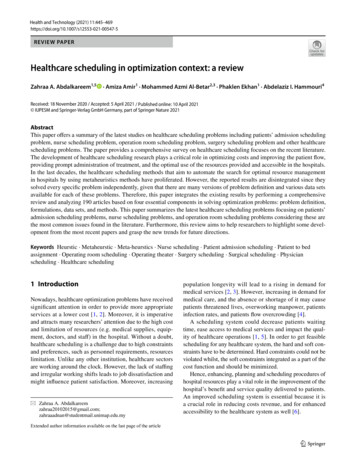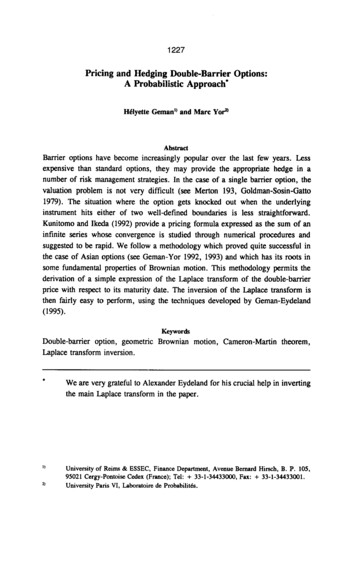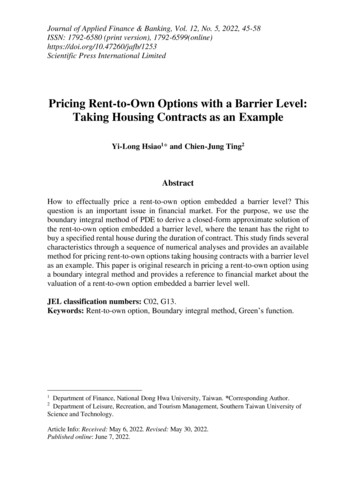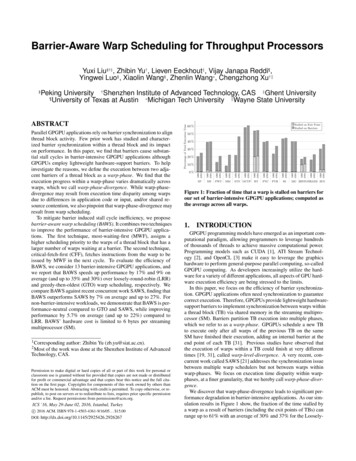
Transcription
Barrier-Aware Warp Scheduling for Throughput ProcessorsYuxi Liu§†‡ , Zhibin Yu† , Lieven Eeckhout‡ , Vijay Janapa Reddi¶ ,Yingwei Luo§ , Xiaolin Wang§ , Zhenlin Wang , Chengzhong Xu†kPeking University † Shenzhen Institute of Advanced Technology, CAS ‡ Ghent University¶ University of Texas at Austin Michigan Tech Universityk Wayne State University1 Correspondingauthor: Zhibin Yu (zb.yu@siat.ac.cn).2 Most of the work was done at the Shenzhen Institute of AdvancedTechnology, CAS.Permission to make digital or hard copies of all or part of this work for personal orclassroom use is granted without fee provided that copies are not made or distributedfor profit or commercial advantage and that copies bear this notice and the full citation on the first page. Copyrights for components of this work owned by others thanACM must be honored. Abstracting with credit is permitted. To copy otherwise, or republish, to post on servers or to redistribute to lists, requires prior specific permissionand/or a fee. Request permissions from permissions@acm.org.ICS ’16, May 29-June 02, 2016, Istanbul, Turkeyc 2016 ACM. ISBN 978-1-4503-4361-9/16/05. . . 15.00DOI: http://dx.doi.org/10.1145/2925426.292626750 %40 %30 %20 %SPMSFWTMMSTN LRRGTOLRRGTOLRRGTOLRRGTOLRRGTOLRRGTOLRR0%GTO10 %LRRParallel GPGPU applications rely on barrier synchronization to alignthread block activity. Few prior work has studied and characterized barrier synchronization within a thread block and its impacton performance. In this paper, we find that barriers cause substantial stall cycles in barrier-intensive GPGPU applications althoughGPGPUs employ lightweight hardware-support barriers. To helpinvestigate the reasons, we define the execution between two adjacent barriers of a thread block as a warp-phase. We find that theexecution progress within a warp-phase varies dramatically acrosswarps, which we call warp-phase-divergence. While warp-phasedivergence may result from execution time disparity among warpsdue to differences in application code or input, and/or shared resource contention, we also pinpoint that warp-phase-divergence mayresult from warp scheduling.To mitigate barrier induced stall cycle inefficiency, we proposebarrier-aware warp scheduling (BAWS). It combines two techniquesto improve the performance of barrier-intensive GPGPU applications. The first technique, most-waiting-first (MWF), assigns ahigher scheduling priority to the warps of a thread block that has alarger number of warps waiting at a barrier. The second technique,critical-fetch-first (CFF), fetches instructions from the warp to beissued by MWF in the next cycle. To evaluate the efficiency ofBAWS, we consider 13 barrier-intensive GPGPU applications, andwe report that BAWS speeds up performance by 17% and 9% onaverage (and up to 35% and 30%) over loosely-round-robin (LRR)and greedy-then-oldest (GTO) warp scheduling, respectively. Wecompare BAWS against recent concurrent work SAWS, finding thatBAWS outperforms SAWS by 7% on average and up to 27%. Fornon-barrier-intensive workloads, we demonstrate that BAWS is performance-neutral compared to GTO and SAWS, while improvingperformance by 5.7% on average (and up to 22%) compared toLRR. BAWS’ hardware cost is limited to 6 bytes per streamingmultiprocessor (SM).Stalled on Exit PointStalled on Barriers60 %GTOABSTRACTPercentage of Total Execution Time§MG HISTO SRAD2 AVGFigure 1: Fraction of time that a warp is stalled on barriers forour set of barrier-intensive GPGPU applications; computed asthe average across all warps.1.INTRODUCTIONGPGPU programming models have emerged as an important computational paradigm, allowing programmers to leverage hundredsof thousands of threads to achieve massive computational power.Programming models such as CUDA [1], ATI Stream Technology [2], and OpenCL [3] make it easy to leverage the graphicshardware to perform general-purpose parallel computing, so-calledGPGPU computing. As developers increasingly utilize the hardware for a variety of different applications, all aspects of GPU hardware execution efficiency are being stressed to the limits.In this paper, we focus on the efficiency of barrier synchronization. GPGPU applications often need synchronization to guaranteecorrect execution. Therefore, GPGPUs provide lightweight hardwaresupport barriers to implement synchronization between warps withina thread block (TB) via shared memory in the streaming multiprocessor (SM). Barriers partition TB execution into multiple phases,which we refer to as a warp-phase. GPGPUs schedule a new TBto execute only after all warps of the previous TB on the sameSM have finished their execution, adding an internal barrier at theend point of each TB [31]. Previous studies have observed thatthe execution of warps within a TB could finish at very differenttimes [19, 31], called warp-level-divergence. A very recent, concurrent work called SAWS [21] addresses the synchronization issuebetween multiple warp schedulers but not between warps withinwarp-phases. We focus on execution time disparity within warpphases, at a finer granularity, that we hereby call warp-phase-divergence.We discover that warp-phase-divergence leads to significant performance degradation in barrier-intensive applications. As our simulation results in Figure 1 show, the fraction of the time stalled bya warp as a result of barriers (including the exit points of TBs) canrange up to 61% with an average of 30% and 37% for the Loosely-
Streaming Multiprocessor (SM)W0 PCW2 PCArbiterW1 PC.decodev W0 Inst.v W1 Inst.::v WN 1 Inst.I-BufferWN 1 PCrr:rIssue UnitWarpSchedulerWarp PoolW0ScoreboardL1I-CacheW1SPissuefetchRegister FileSFUSharedLD/ST.Round-Robin (LRR) [1] and Greedy-then-Oldest (GTO) [26] warpthe arrier. If warps have same priority, wewarpwithwarp id forthe benefit fromNo priorhighlightwork, tothethebestof smallestour knowledge,hastocomprehenwarps’ interleavedexecution.Second,we propose ata criticalsively characterizedand studiedhow barriersynchronizationtheapproachto fetch morecritical e.We thereforeanalyzeinstructionwarpinto I-Buffer,the gapbetweenfetchstage’sphase-divergenceand wethusfindoverlappingthere are severalsourcesof theprobarbiter code,and IssueStage’sscheduler.the offlineandpolicy,lem: applicationinputdata, warpsharedresourceForcontention,we wantto identicalwarpsthatsomewarp e-dependentmay causebenchmarkscompilerstage.ThusCWsare inprioritizedwarps to executealongondifferentpaths,whichmayresultexethe startingtime.resource contention may also leadcution timefromdisparity.Sharedto execution Usingtime disparity,thoughwarpsare 14%executingtheBAS, ourevenonlinepoliciesachieveperformancesame code.improvement.A much eup to of42%IPC improvedivergencement.is the warp scheduling policy, which may lead to dramatically different execution rates as warp scheduling may prioriThis paper make the following contributions:tize some warps over others. We firstcharacterizestalledlatency proposedcaused ouslynizationsuchbarrierswithin a block [14]in synchronization-intensivescheduling policies,as prefetch-awareand memory-awareGPGPUprograms,causesof the fine-grainedscheduling [12,13, 23,26], doidentifynot takethreebarrierbehaviorinto acwarp-leveldivergence.count. As a result, the warp scheduler does not schedule the slowproposetoa executenovel online/offlineschedulingest warp in a Wewarp-phasewith the highestpriority,policy:which may lead to dramatic execution disparity between warps in aofTBwaiting forit; onfetchduringstage thewarpbarrierinstructionhas theand cause substantialstallcyclesof thatthatwarphighestexistingprioritywarpwouldto fetchedintoonlyI-Buffer.Offlinephase. In addition,schedulersfocuson nning.ing warps in a better way at the issue stage of a GPGPU SIMD licyand expipeline, butleavethe warp andselectionat thestageplains whythe policyis usefulto alleviateas is in a round-robinfashion.However,withbarriers, thethe stall.instruction fetch unitThemayrestfetchfor a warp asthatfollows.is waitingatof antheinstructionpaper is organizedSectiona barrier whilean instructionneeded bytoanothercritical warp is not and2 givesa brief introductionGPU micro-architecturefetched, furtherexacerbating the stalls.synchronization-intensivebenchmarks we used. CharacteriTo addresstheofbarrier-inducedstall cycle inefficiencywarp- onzationsynchronization-intensiveprograms isatrevealedphase granularity,propose4 barrier-awarewarp scheduling(BAWS).Section we3. Sectiondescribes our schedulingpolicy andexperThis new imentalpolicy isresultsa hybridapproacharethatcombinestwo 5.onlineand analysesshownin SectionRelatedtechniques.worksThe keyof ourinfirsttechnique,most-waitingare ideadiscussedSection6 andcalledSection7 concludes thefirst (MWF),is based on the following insight: by scheduling thepaper.warp in a TB that has the largest number of other warps waiting forit at a barrierexecute first, we can reduce the number of stall cy2. toBackgroundcles before that barrier. Our second technique, called critical-fetchfirst (CFF), builds on top of MWF and fetches the instruction forThis section we give a brief description of the GPGPU archithe warp that is the most likely to be issued by MWF in the next cytecture we used, baseline warp scheduling policies used oncle. CFF eliminates the idle cycles caused by the warp schedulingGPGPU-sim simulator, and synchronization-intensive benchmismatch between the fetch and issue stages in a GPGPU pipeline,marks we used to characterize synchronization problems.specifically in the context of barriers.In summary, the contributions of this paper are as follows:2.1. Baseline Architecture We show that barriers cause significant performance degraWeinuseGPGPU-sim (version3.2.2)[1] to profiledationbarrier-intensiveGPGPUworkloads,and weprograms’percharacterization.is a detailedsimformsynchronizingan in-depth andcomprehensiveGPGPU-simcharacterizationof GPGPUulationmodel of a GPU architecture such as NVIDIA’s Fermibarrierexecution.and GT200 architectures. NVIDIA Fermi GTX480 is our We baselinemitigate GPUbarrierstall cycle andinefficiencyby introducingconfigurationit’s architectureis shown intwo Figurenew warpschedulingalgorithms, namedMWFthe1. Ourdetailed CFF forthe fetch stageGPGPUSIMDTableand1. Furtherinformationcould ofbe afoundin [32,1]. Thepipeline.MWF(most-waiting-first)a warp thathastype:back-endpipelineGPGPU-sim choosesmodels containsthreethe largestnumberof otherwarpsfortranscendentalit to execute inSP, SFUand LD/ST.SFUunitswaitingexecutesfirst.structionsCFF (critical-fetch-first)first fetchestheofinstructionforand SP units executesall typesALU instructionsa warpthattranscendentals.is the most likely to be issued by MWF in theexceptnext cycle.WN 1L1-DL1-CL1-TFigure 1: Baseline GPU architecture modeled.Figure 2: Microarchitecture of an SM.ArchitectureNVIDIA Fermi GTX480Number of SMs15formsSAWSWarpsize [21] by 7% on average and32 up to 27%. Moreover,for widthnon-barrier-intensive workloads,we demonstrateSIMD32thatofBAWSis performance-neutralcomparedto GTO andMax.Warps perSM48SAWS,whileperimprovingperformance8 by 5.7% on averageMax.of BlocksSM(andto 22%)compared to LRR.1536Hardware required forMax.of upthreadsper SMimplementingBAWSislimitedto6bytesShared memory48KB per SM.per SM as follows. Section32768TheRegisterspaper is organized2 describes the backData16KB per SM32-sets)ground L1abouttheCacheSM microarchitectureand(4-way,two warpschedulingL1 InstCache2KB perSM (4-way, the4-sets)algorithms:LRRand GTO. Section3 characterizesbarrier beL2 Cachetotal (8-way,havior in GPGPUworkloads. 768KBSection in4 describesour 64-sets)barrier-awareof SPunits policy. Section 5 depicts2warp Numberscheduling(BAWS)our experimental setup.Sectionprovides the evaluation1 results and analysis.Numberof SFU6 unitsSection 7 describes related work, and Section 8 concludes the paTable 1: GPGPU-Sim Configurationper.Warp Scheduling on fetch and issue stage2.2.2. BACKGROUNDGPGPU-simuses separateon Fetchhierarchicaland Issue Unit.GPGPU hardwareemployspolicya three-levelarchitecBy defaultround-robin(RR)used on executesfetch stageture:a streamingprocessor(SP)policywhichislogicallya warp;load instructionsinto I-buffer,and Looselya tostreamingmultiprocessor(SM) consistingofRound-Robinmany SPs, which(LRR) schedulingon issueBesidesGTO conphysicallyexecutes policywarps isin usedparallel;and astage.GPGPUprocessor(GreedyThen Oldest)policyis thesupplementaryfortaininga numberof SMs,whichrunsa grid of TBs.policyWe describecharacterizationand comparison.Both LRRGTO aretheSM microarchitecturein detail becausewarpandschedulingoccursin GPGPU-sim,andsubsequentlyGTO schedulingpolicyhasatprovidedthe individualSM level. Weprovidean overviewresults than[28]. used warp scheduling algorithms:ofbettertwo existingand LRRmost widelyloosely-round-robinand greedy-then-oldestThe reason why (LRR)GTO performsbetter than LRR(GTO).has beenstudied at [28, 20]. [28] reveals that prioritizing older warps2.1SM Microarchitecturewith higherintra-warp locality can reduce memory requestThe frommicroarchitectureof a singleGPGPU[20]coreexhibitsis composedcostsimproving L1D-Cacheefficiency.that ofa GTOscalarpolicyfront-endanda SIMDback-end, asgives(fetch,more decode,priority issue)to olderwarpsby allowingillustratedin earlier.Figure 2.Followinguse of terminology,them finishThennew TBsNVIDIA’swould be launchedon SM. aSIMDof manylanesknownas StreamThereback-endis anotherconsistsimportantreasonSIMDis lFunctionUnit (SFU),andLoad/Storeat differentwouldlike to utilizedifferentpipelineunit(LD/ST).A GPGPUcore namedas theStreamingMulti-processorunitsconcurrently.This couldalleviatecompetitionfor the(SM)NVIDIAunits.typically has 32 SPs that share a single scalarsamebyfunctionalfront-end.focus on thewhywarpschedulingpolicyFigure 2Sincegiveswean explanationGTOsuffers lessfromat dsimplifystructural hazard than LRR. With a round-robin warp schedtheillustrationof thestructureFigure 2. contenduler,every warpwillback-endlikely issuesimilarininstructionsThereare same6 importantstructuresin thewhichfront-endingfor thefunctionhardwareunit (resourceconflict),will of struccause significant structural hazard latency. While GTO alwaystion buffer (I-Buffer), fetch, branch, decode, and issue unit. Thefetch unit fetches instructions from the I-Cache according to pro2gram counters (PC). The I-Buffer serves as a temporary instruction We combine MWF and CFF to form the barrier-aware warpscheduling (BAWS) policy and evaluate it by using 13 barrierstation after an instruction is decoded but before it is issued to exeintensive GPGPU benchmarks. The results show that BAWScute. Each warp has a fixed number of slots (e.g., 2) in the I-Buffer.(MWF CFF) improves performance for the experimented bench- Each I-Buffer slot contains a v-bit indicating whether an instruction is present and an r-bit indicating that it is ready for execution.marks by 17% and 9% on average (and up to 35% and 30%)over LRR [1] and GTO [26], respectively. BAWS outperInside the issue unit, there is a warp scheduler selecting warps to
execute according to a certain warp scheduling algorithm. Basedon this microarchitecture, GPGPUs employ the Single InstructionMultiple Thread (SIMT) execution model in which multiple threadsare grouped together to form a warp or wavefront executing in alock-step manner.Scheduling for the Fetch and Issue StageAt the fetch stage, a warp is eligible for instruction fetching if itdoes not have any valid instructions within its I-Buffer slots. Typically, eligible warps are scheduled to fetch instructions from the ICache in a round-robin manner. At the issue stage, the warp scheduler selects a warp with a ready instruction in the I-Buffer accordingto a certain scheduling algorithm to issue. Once an instruction hasbeen issued, its corresponding v-bit is altered to invalid. Then thefetch unit is signaled that it may fetch the next instruction for thiswarp.The commonly used warp scheduling algorithm for the issuestage is loosely-round-robin (LRR) [1]. The LRR warp scheduling algorithm treats warps equally and issues them in a round-robinmanner. If a warp cannot be issued, the next warp in round-robinorder is to be issued. Although LRR considers fairness betweenwarps, it does not take warp-specific features such as long memorylatency into account. To address this issue, a lot of memory-awarewarp scheduling algorithms have been proposed [12, 13, 14, 23,26].Amongst the various algorithms, the greedy-then-oldest (GTO)warp scheduling algorithm [26] generally outperforms the otherones for most GPGPU benchmarks. We provide a brief description about GTO because we compare against it in this paper. GTOruns a warp until it stalls, and then picks the oldest ready warp. Theage of a warp is determined by the time it is assigned to the SM.However, GPGPUs assign warps to an SM by the granularity of athread block (TB) and hence all warps in a TB have the same age.In such a case, the warps are prioritized by warp-id: the smallerwarp-id gets the higher priority.Typically, LRR suffers more from structural hazards than GTO.In each cycle, LRR selects a new warp to execute in a roundrobin fashion. Since GPGPUs are based on the SIMT computingparadigm and a warp consists of a fixed number of threads, it ishighly possible that the current warp executes the same instructionas that of the previous warp. In addition, most GPGPU computingoperations such as ADD take several cycles to complete. As such,adjacent warps contend severely for the same compute resources,such as the SP and SFU units, and warps with a larger id have towait. In contrast, GTO lets an SM greedily execute the instructions in a single warp. As such, GPGPU performance benefits fromtwo aspects: (1) better instruction and data locality of threads andincreased cache hit rate; and (2) less resource contention betweenwarps.3.BARRIER CHARACTERIZATIONThe goal in this paper is to mitigate barrier induced stall cycleinefficiency. Before introducing our barrier-aware warp schedulingpolicy in the next section, we now first define terminology and characterize barrier behavior with a specific focus on barrier imbalancedue to warp scheduling.In a barrier-intensive GPGPU application, the execution lifetimeof a warp can be divided into multiple phases, called warp-phases.For example, Figure 3 illustrates the execution of the 8 warps inTB0 running on SM0 for the BT (B Tree) benchmark. The lifetime of the 8 warps is divided into 5 warp-phases by 4 explicitbarriers and 1 implicit one that corresponds to the exit point forTB0.Phase 1Warp ID2.2Temporal resourcewasted onbarriersPhase 2Phase 3Temporal resource wastedon exit pointPhase 4Phase 576543210123 4Synchronization barriers encountered5(exit point)Figure 3: Warp-phases for TB0 on SM0 for benchmark BT(B Tree).The execution progress of the warps before a barrier may be dramatically different (as is the case for barriers 1, 3, 4, and 5), but itcould also be (approximately) the same (barrier 2). Xiang et al. [31]and Lee et al. [19] observe similar execution disparity before theexit point of a TB (barrier 5) and call it warp-level-divergence. InFigure 3, we observe that divergence also happens within a finergrained warp-phase, and we thus refer to this new observation aswarp-phase-divergence.There are a number of sources of warp-phase-divergence. Onesource is code-dependent disparity: different threads execute different code paths (i.e., the code being executed depends on the threadid), which may lead to execution time disparity among warps. Another source is input-dependent disparity: different threads, althoughexecuting the same code path, may also lead to execution timedisparity among warps as they work on different input data (i.e.,branch divergence triggered by data values). Yet another sourceof execution time disparity among warps is resource contention inshared resources such as cache and main memory. While thesesources of warp-phase-divergence are quite intuitive, we focus hereon an additional source of warp-phase-divergence induced by thewarp scheduling algorithm itself, which is much less well understood.3.1Warp Scheduling DisparityWarp scheduling may induce warp-phase-divergence by prioritizing some warps over others at the warp-phase level. For example, GTO always runs a single warp until it stalls because ofits greedy nature; GTO then prioritizes the warp with the smallestwarp-id over other warps. Figure 4 (left) shows the execution ofthe first three TBs scheduled by GTO for the FWT benchmark asan example. Each TB is executing 16 warps. According to GTO,the warps in TB0 are scheduled to execute first since they have theoldest age (highest priority). For the warps in the same TB whichhave the same priority, GTO schedules the warp with the smallest warp-id to execute first upon a stall. As a result, the warps inTB0 execute faster than those in TB1 and much faster than thosein TB2. In particular, in TB2, warp-47 is the slowest warp, uponwhich warp-32 (which arrived at the barrier first) has been waiting for approximately 3,800 cycles (see warp-phase 1 in TB2). Inaddition, there are many stall cycles in other warp-phases such aswarp-phases 3 and 5 in TB1, and warp-phase 2 in TB2. Althoughthe number of stall cycles in these warp-phases is smaller than forwarp-phase 1 in TB2, it still accumulates to a significant number ofstall cycles.It is interesting to compare the execution behavior under GTO,see Figure 4 (left), against the execution behavior under LRR, seeFigure 4 (right), again for the first three TBs for FWT. Clearly,LRR achieves a much more balanced execution compared to GTO,
471234567840234524TB116123 4 2,00011682TB2326 7 8Warp ID1140TB232Warp ID4710,00012,00014,00016,000 CycleTB002,0004,0006,0008,00010,00012,00014,000 CycleFigure 4: Execution of TB0, 1 and 2 on SM0 for FWT under GTO (left) and LRR (right); there are 16 warps per TB; the numbersrepresent warp-phase ids.1LRRGTO60 %234RTRU50 %TB54040 %TB430 %3210 %SPMSFWTMMSTN OCTPBTPVCPVRSSMG HISTO SRAD2Warp ID20 %0%547TB324TB216Figure 5: RTRU under LRR and GTO.TB18as LRR selects warps in a round-robin fashion. In other words,GTO leads to increased warp execution disparity. Nevertheless,GTO outperforms LRR: TBs 1 and 2 finish much earlier underGTO than under LRR, which enables other TBs to execute earlier (not shown in the Figure). The reason why GTO outperformsLRR is because it reduces the number of structural hazards, as wewill quantify later in this paper. The reduction in structural hazardsoutpaces the increase in warp execution disparity, which ultimatelyleads GTO to outperform LRR.3.2RTRU CharacterizationTo systematically quantify the number of stall cycles due to warpscheduling disparity, we use the ratio of temporal resource underutilization (RTRU) metric defined by Xiang et al. [31]. RTRU wasoriginally proposed for quantifying execution disparity at TB exitpoints. We adopt this definition to quantify disparity at the warpphase level as follows:Â(maxTRT RU iTi ),(1)N · maxTwith maxT the longest execution time of all warps, Ti the execution time of warp i, and N the number of warps. As such, RTRUindicates the execution imbalance of warps within a warp phase.Smaller is better: a small RTRU indicates less imbalance, whereasa high RTRU indicates high imbalance.Figure 5 quantifies RTRU for all of our barrier-intensive benchmarks under LRR and GTO. It is remarkable that the executionimbalance among warps in a warp phase is substantial for thesebarrier-intensive benchmarks. For several benchmarks we reportTB002,0004,0006,000CycleFigure 6: Warp-phases for TBs 0 through 5 for the BT benchmark.RTRU values in the 20% to 50% range, and up to 60%. It is alsointeresting to note that the imbalance is typically larger under GTOthan under LRR, most notably for FWT, MM, STN and PVR.The data implies that warp scheduling may exacerbate the warpphase-divergence problem inherent to a workload. Note though,again, that GTO typically outperforms LRR by reducing the number of structural hazards, as we will quantify later in this paper. Thegoal hence is to improve performance beyond GTO by reducingwarp execution disparity while not introducing structural hazards,as LRR does.3.3Critical WarpsBefore presenting barrier-aware scheduling (BAWS), we first wantto illustrate the need for an online mechanism. Warp-phase-divergenceleads to substantial execution time disparity at small time scales, asargued before. Some warps may reach the barrier before others do,turning the lagging warps to be critical warps, i.e., the thread blockis waiting for the critical warp(s) to also reach the barrier beforeproceeding to the next warp-phase. Critical warp(s) may vary overtime. This is illustrated in Figure 6 for the BT benchmark: the critical warp in TB0 varies from warp 0 (in phase 1), warp 2 (in phase3), warp 0 again (in phase 4), to warp 3 (in phase 5). This illustrates
TB 0TB 1TB 2w0 w1 w2 w3w4 w5 w6 w7w8 w9 w10 w11index TB-id012priority123timeTable 1: The warp priority table (WPT).BarrierBarrierBarrierFigure 7: Overview of Most-Waiting-First (MWF) warpscheduling at the issue stage. We assume that there are 3 TBsrunning on a single SM concurrently and each TB contains 4warps.that we need an online mechanism to dynamically identify criticalwarps to accelerate.4.BARRIER-AWARE WARP SCHEDULINGBarrier-aware warp scheduling (BAWS) consists of two warpscheduling algorithms for the issue and fetch stage, respectively.The warp scheduling algorithm for the issue stage is called mostwaiting-first (MWF); the one for the fetch stage is named criticalfetch-first (CFF).4.1Most-Waiting-First Warp SchedulingThe insight behind MWF is to schedule warps in a TB that havethe largest number of other warps waiting for it at a barrier to execute first. In doing so, we improve performance by reducing thenumber of stall cycles before barriers.4.1.1MechanismMWF is an online technique that assigns priorities to warps atthe moment when there is at least one warp that is at a barrier.MWF assigns the highest priority to the warps in a TB that has thelargest number of warps waiting at a barrier. These warps are calledcritical warps. Warps in the same TB have the same priority. If twoor more TBs have the same number of barrier-waiting warps, MWFassigns the highest priority to the warps in the TB with the smallestTB-id, similar to what GTO does for warps.We consider two variants to MWF with respect to schedulingwarps (with the same priority) within a TB. The MWF(LRR) variantemploys LRR within a TB, and starts from the warp next (in roundrobin order) to the one which was issued in the last cycle in the TB.The second MWF(GTO) variant employs GTO, and starts from thewarp issued in the last cycle, and if that one is stalled, it selects theoldest warp in the TB (i.e., with the smallest warp-id) to go next.We will evaluate both variants of MWF in the evaluation section.Figure 7 shows how MWF scheduling works. Six warps fromthree TBs have arrived at their respective barriers, waiting for theother six warps. The number of stalled warps because of barriersfor TB0, TB1, and TB2 are 1, 2, and 3, respectively. MWF assignsthe highest priority 3 to the warps in TB2, a lower priority 2 to thosein TB1, and the lowest priority 1 to those in TB0. For the TBs (TB0and TB1) that have more than one warp that are still running, MWFemploys either (i) LRR to schedule these warps starting from thewarp next (in round robin order) to the one which was issued inthe last cycle — the MWF(LRR) variant — or (ii) GTO to schedulethese warps from the one issued in the last cycle and then oldest —the MWF(GTO) variant.For example, consider MWF(LRR) and assume the warp issuedin the last cycle is w7 in TB1 and it reaches the barrier in the currentcycle, MWF would schedule w4 to execute because it is the nextwarp to w7 in round-robin order. For TB0, suppose the warp lastlyissued is w0, MWF would schedule w1 to execute. As a result, thescheduling orders of the 6 running warps of the three TBs in thecurrent cycle are w8, w4, w6, w1, w3 and w0. For the warps in twoor more TBs which have the same priority, suppose there is anotherTB (TB3, not shown in Figure 7) that also has two warps waitingat a barrier, then warps in TB3 have the same priority as those inTB1. In this case, MWF assigns higher priority to the warps in TB1because its id is the smallest between TB1 and TB3.Note that MWF naturally handles multiple warp schedulers perSM if we maintain one shared list of TB priorities. TBs with thehighest priority will be prioritized by the respective warp schedulers.4.1.2Hardware SupportHardware support for synchronization is available in modern GPGPUs [21]. A global synchronization control unit (SCU) keeps trackof the barrier status for all warps within each TB and all TBs withinan SM. The unit keeps track whether a warp is waiting on a barrier,and raises a signal once a barrier is cleared. BAWS requires a smalladdition to the SCU. We propose the warp priority table (WPT)to maintain the warp priorities on an SM. The WPT has as manyrows as there are TBs, with each entry in the table containing theTB’s priority, or the number of warps in the TB that have arrived atthe barrier, see Table 1. A TB’s priority is a counter that is incremented when one of its warps reaches the barr
GPGPU-sim simulator, and synchronization-intensive bench-marks we used to characterize synchronization problems. 2.1. Baseline Architecture We use GPGPU-sim (version 3.2.2) [1] to profile programs' synchronizing characterization. GPGPU-sim is a detailed sim-ulation model of a GPU architecture such as NVIDIA's Fermi and GT200 architectures.
